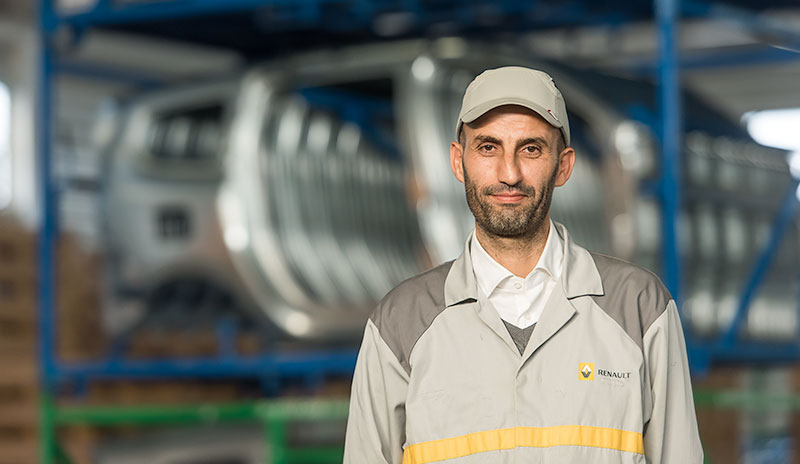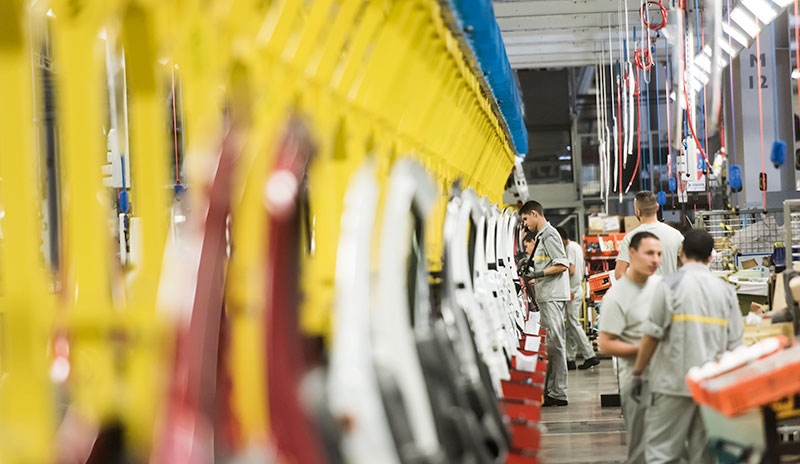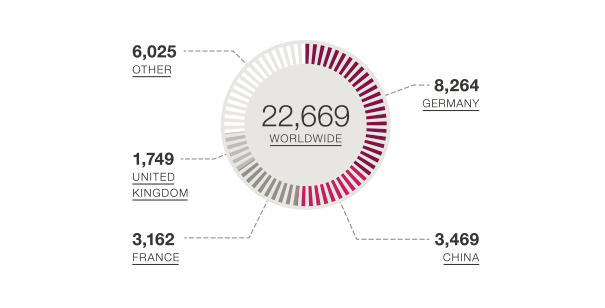Motivated.
Motivated employees are the bedrock of innovation, quality, competitiveness, growth and the opening up of new markets – such as Africa. One of the beneficiaries is Renault in Tangier, where it is making speedy progress thanks to its dependable trucks from the KION Group.
Motivated employees are the
bedrock of innovation, quality,
competitiveness, growth and the
opening up of new markets –
such as Africa. One of the
beneficiaries is Renault
in Tangier, where it is
making speedy progress
thanks to its dependable trucks
from the KION Group.
Red, white and black cars yet to be fitted with interiors hang one and a half meters up in the air, suspended from yellow grippers. Lodgy, Dokker and Sandero are the three models produced by the Renault-owned Dacia brand in the factory in Tangier, Morocco. As for which of these models the shiny new car bodies will emerge as, that’s something that only someone like Mohammed el-Bakrimi can know.
The 43-year-old has worked for Renault since the Tangier factory opened back in 2012. Like many others, he moved to this up-and-coming city on the Strait of Gibraltar especially to take up one of the 5,000 or so jobs offered by Africa’s biggest car factory. The father of two children from the Casablanca region has always been fascinated by car engines and bodywork: “I used to run a car workshop.” Nevertheless, when he joined Renault he had to start where nearly all new employees do: inside the long and narrow training centre that stands right by the entrance to the 300-hectare factory site.
El-Bakrimi spent two months learning how to instruct workers in assembly. He has since gone on to become head of material handling at the factory, making sure that engines, panels, seats and screws reach the assembly line at the right time. Computers monitor what needs to be where when. The materials are stored on huge racks ten metres high, right at the back of the factory building. “This is where the forklift trucks perform their ballet moves,” declares el-Bakrimi with pride. 110 trucks from Fenwick, KION’s French regional brand, are put to work in the Renault factory, delivering parts to the assembly lines at the precise minute they’re needed. That’s why they can be seen darting up and down the long aisles, sometimes at breakneck speeds.
Each day, 800 cars roll off the assembly lines
“Sometimes there are accidents,” admits el-Bakrimi. All the more reason for the man who never takes off his grey cap, not even at mealtimes, to value anything that improves safety. For example, the BlueSpot warning system – an intense blue spotlight that alerts passers-by to the moving truck. Because with all the sirens, the hammering and the hissing of compressed air on the shopfloor, it gets so loud that many drivers have deactivated the reverse warning sound on their trucks.
And out the back in the ‘shop’, as the materials store is otherwise known, the nimble Fenwicks weave in and out of the aisles. Abdelmounim el-Tounani is one of the drivers. “I really appreciate the different ways you can handle materials, with the telescopic forklifts for instance,” says the 27-year-old, who worked in a café in Tangier before joining Renault. The ultra-modern factory, which currently produces some 800 cars each day, is a world away from the hustle and bustle of the old town with its 700,000 residents, its little shops and its street hawkers haggling over every last dirham.
Nevertheless, many employees still make time for their prayers while at work in the factory, which has been built on a greenfield site roughly 30 kilometres outside Tangier. A space next to the staff room has been separated off and laid with carpet, where workers can go for worship. Prayer times are determined by the production process rather than the muezzin. “Allah will forgive me for missing the hours of prayer because I’m at work, I just pray later on instead,” says el-Bakrimi.
He is proud of Renault Tanger’s pioneering green credentials. The factory’s operations produce virtually no carbon emissions. Over a dozen wind turbines can be seen turning in the hills around the factory, supplying electricity to the site. The hot water used in the paintshop is heated using biomass obtained from the stones of Moroccan olives.
The biggest sales market for the Moroccan-made Dacias is Renault’s domestic French market, followed by Spain. From the seaside promenade in Tangier, Spain’s coast looks close enough to touch, being only 14 kilometres away. Tangier’s geographical position was another reason Renault chose the site. It only takes a day and a half to ship the vehicles to France from Tangier’s state-of-the-art container port, Tanger-Med. Renault, who invested one billion euro in the facility, also benefits from the location in other ways, such as the lower labour costs in Morocco.
The factory, which has created a further 30,000 or so indirect jobs, is a crown jewel of sorts for the newly industrialising country. It’s no wonder then that King Mohammed VI himself came along for the factory’s opening in February 2012. Mohammed el-Bakrimi remembers the monarch’s appearance as if it were yesterday. “I’d seen His Majesty open many factories before, but he looked especially happy to be opening ours that day,” he recalls.





